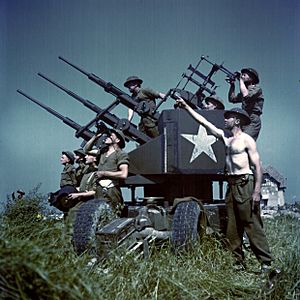20 mm Polsten facts for kids
Quick facts for kids Polsten |
|
|---|---|

A Canadian towed anti-aircraft mounting featuring three Polsten cannons.
|
|
| Type | Autocannon |
| Place of origin | Poland, United Kingdom |
| Service history | |
| In service | 1944 - 1950s |
| Production history | |
| Designed | 1939-1941? |
| Manufacturer | John Inglis |
| Unit cost | £60 - £70 |
| Specifications | |
| Mass | 57 kg (126 lb) |
| Length | 2.1 m (6 ft 11 in) |
| Barrel length | 1.45 m (4 ft 9 in) (barrel) |
|
|
|
| Calibre | 20 mm (0.78 in) |
| Rate of fire | 450 rpm |
| Muzzle velocity | 830 m/s (2,700 ft/s) |
| Effective firing range | 1,000 m (3,281 ft) |
| Maximum firing range | 2,000 m (6,562 ft) |
| Feed system | 60 round drum magazine or 30 round box magazine |
The Polsten was a powerful 20 mm gun. It was created by Polish designers. The Polsten was an improved version of the Oerlikon gun. Its main goal was to be much simpler and cheaper to build. However, it still needed to work just as well as the Oerlikon.
Contents
How the Polsten Gun Was Developed
When Nazi Germany attacked Poland in 1939, the Polish design team had to leave their country. They went to the United Kingdom. There, they continued their work with designers from Czechoslovakia and Britain. The idea for the Polsten gun came up around June 1941.
The Polsten gun started being used in March 1944. It was used alongside the Oerlikon gun. Both guns used similar drum magazines that held 60 rounds. The Polsten could also use a simpler box magazine with 30 rounds. This gun stayed in service until the 1950s.
How the Polsten Was Used
The Polsten gun was much simpler inside. The Oerlikon had 250 parts, but the Polsten had only 119. Even with fewer parts, it worked just as well and was very reliable. Its simpler design also made it much cheaper to produce. One Oerlikon gun cost about £350. A Polsten gun, however, cost only £60 to £70.
In January 1944, the 21st Army Group decided to use only Polsten guns. They became the main light anti-aircraft gun. This helped make sure supplies were simpler for the army. British infantry battalions used the Polsten in their anti-aircraft platoons. This was during the Western European campaign in 1944-45.
The Polsten was also used by airborne units. They used it to defend against enemy aircraft. For example, it was used during Operation Market Garden. The gun was often placed on a wheeled stand. This stand could be pulled by a jeep.
Polsten on Vehicles
The Polsten gun was put on armored vehicles. These vehicles were designed to shoot down planes. Some were based on the Cromwell/Centaur tank. It was also used on the Skink anti-aircraft tank.
The Polsten was also mounted on British LVTs. These were special vehicles that could travel on land and water. Early models of the Centurion tank also had a Polsten gun. It was placed on the left side of the turret, separate from the main gun.
Many different setups were made for the Polsten. These included mounts with two, three, or even four guns together. John Inglis Limited in Toronto, Canada, made thousands of these guns. They also produced about 500 mounts with four guns. These saw some limited use at the end of the war. These multi-gun mounts were either pulled by trailers or put on trucks.
Polsten guns, magazines, and ammo boxes were also made in Australia. General Motors Holden produced them during World War II. The Australian Army used them on land and on small boats. Some test gun mounts were also developed, but they were not used in service.
What's in a Name?
The exact meaning of the name "Polsten" is not fully clear. Some people think it comes from "Poland" and "Sten Company." However, the Sten gun was not made by a company called Sten.
Official sources from the United Kingdom give another idea. They say the name combines "Poland" and the Royal Small Arms Factory in Enfield. This is similar to how the Bren gun got its name (Brno + Enfield). The Sten gun also got its name from its designers (Shephard, Turpin + Enfield).
The name also showed that the gun's design was mostly Polish. The magazine design was mostly Czech. Eight Polish engineers were part of the design team. The "Sten" ending might also have suggested that the Polsten was a cheaper and faster gun to make, just like the Sten gun was.
Who Used the Polsten Gun?
Past Users
See also
- Polski Sten, a different Polish version of the Sten gun

